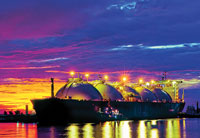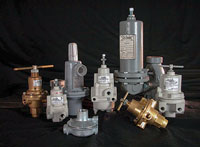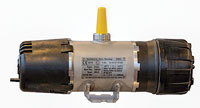New in gas processing technology
H. Meche, Associate Editor
Pumps for demanding applications
 |
Maag’s new S Series of screw pumps is said to offer the process industries a variety of options for conveying challenging fluids. These rotary positive-displacement pumps provide numerous advantages over conventional technologies, including:
- ATEX certified for use in explosive or dangerous environments
- Self-priming capability and good suction performance
- Excellent speed/output linearity
- Low pulsation
- Constant flow, even at considerably different pressures and volumes
- Compact footprint and ease of maintenance.
The basic design of the pump entails two screws, a drive screw and an idler screw. During pump operation, these integral shaft screws are engaged and form a sealed cavity with the surrounding pump housing. The pumped liquid is transported axially as the screw shafts turn and is conveyed in a consistent and pulseless flow to the pump discharge port. Since hydraulic forces on the two screws are balanced, there is little to no hydraulic stress on the screws, promoting maximum life of the internal pump parts.
Twin-screw pumps can be a good option for conveying challenging multiple-phase fluids containing oil, gas and water in the oil and gas production sector.
In a variant of the S Series, the twin screw pumps employ timing gears to transmit the power from the power screw shaft to the idler screw shaft to reduce the possibility of wear when pumping abrasive materials, or where special materials of construction dictate noncontacting operation.
Maag also offers a multiphase fluid option designed for medium- to low-pressure applications.
LNG PRV boosts flow efficiency
 |
Pentair Valves & Controls is expanding its Anderson Greenwood pressure-relief product range with the launch of an improved design of its pilot-operated pressure relief valve (POPRV) model for LNG storage in onshore and offshore applications. The Anderson Greenwood 9300H PORPV offers LNG operators a key advantage by increasing flow capacity by 30%, enabling the design and construction of larger storage tanks without the need to increase valve sizes. In addition, the compact model minimizes equipment footprint, which is especially critical for LNG vessels where space is limited. The increased robustness and durability of the valve also provide for significant savings on overall maintenance costs, as the valve requires less frequent and easier repair services.
As the size of LNG storage tanks is increasing, valve flow capacity must meet these growing requirements for optimum performance. Additionally, the special requirements of LNG storage applications make it necessary for valve equipment to accurately maintain the preset pressure and resolve any events that occur outside of these configurations. The Anderson Greenwood 9300H valve design overcomes these two key challenges in LNG storage applications. By providing increased flow, the valve can efficiently and quickly relieve pressure without the need to increase its size, offering LNG carrier owners and plant operators design flexibility. This is a vital advantage in LNG pressure-protection applications, where cost-effectiveness, operational efficiency and maintenance are crucial to reducing unplanned operational downtime.
The 9300H model comes in sizes from 2 in. × 3 in. to 12 in. × 16 in., with sturdy body casting and simplified trim design for easier maintenance. Its pilot, mounted directly on the valve cap, provides a lower and more compact valve profile and increases its sturdiness for more stable flows. This shorter body design is fully versatile and can accommodate both onshore and offshore storage requirements. In addition to its increased flow capability, the new valve handles a large temperature range and features a self-draining body and low sensitivity to backpressure within the exhaust piping. The valve also significantly reduces the possibility of leakage by enhanced seating forces and improved seat design.
SS regulators for corrosive environments
 |
The BelGAS division of Marsh Bellofram Corp. has expanded its product portfolio to include stainless steel (SS) versions of the Type P95H, Type P98H and Type P627 regulators for corrosive environments.
The SS BelGAS Type P95H regulator is a direct-operating pressure-reducing regulator. It is suitable for a wide range of applications, including air, steam, process gases, corrosive liquids, oil and gas. The regulators are available in three different spring ranges, with a choice of either a metal or an elastomeric diaphragm; as well as various orifice seat materials. Type P95H gas pressure regulators offer rugged, corrosion-resistant construction, large flow capacities, ease of operation and set pressures, leak-tight operation, and fully tapped unit vents. Their inline maintenance capabilities also reduce equipment downtime. Typical applications for the BelGAS Type P95H regulators include steam and corrosive gas injection; inline gas, chemical and liquid control; chemical boilers; and process heaters.
Type P98H is a backpressure regulator and relief valve. It is designed to monitor upstream pressure and opens to relieve excess pressure increases above the setpoint. As a backpressure regulator, the Type P98H instrument helps ensure that upstream pressure is monitored and released; then downstream, when setpoint is exceeded.
Type P627 spring-loaded, direct-operated, low- and high-gas-pressure regulators feature a wide range of flow capacities. They feature a durable powder-coated epoxy exterior, installation versatility, multiposition body and spring-case configurations. In addition to its new SS version, the regulators are alternatively available with an external pressure registration model and NACE-compliant construction.
Regulators provide precise control
 |
A new series of highly durable specialized gas regulators designed to provide accurate control of systems operating under vacuum has been introduced by AURA Controls. The EXS Sub-Atmospheric Series regulator provides precise control under subatmospheric conditions, along with low setpoint and low-flow positive-pressure applications. Its proprietary hybrid spring design works in tandem with an oversized dual-surface diaphragm to enable sensitive control, in contrast to a standard regulator design that loses the ability to control pressure when subject to downstream vacuum.
Insulating microfiber cryogenic media
Lydall Performance Materials, a division of Lydall Inc., has launched a new product addition to its cryogenic insulation portfolio. CryoTherm 233B incorporates a unique biosoluble microfiber to address the raw material health and safety concerns of cryogenic vessel and piping manufacturers without sacrificing performance. This new product is said to be the first cryogenic insulation available using non-biopersistent glass microfibers.
CryoTherm, CRS-Wrap and CryoLite have been used to insulate transport and industrial process piping, as well as tanks ranging in size from portable gallon to O2 dewars to liquefied gas storage tanks over 250,000 gal in size.
Norwegian firm achieves certification
 |
GasSecure, a Norwegian gas detection company recently acquired by Dräger, has secured third-party safety integrity level (SIL) 2 certification for its GS01 wireless gas detector. After months of detailed assessments, the GasSecure GS01 wireless hydrocarbon gas detector was recently certified by third-party assessor Exida as SIL 2-capable for use in safety instrumented systems per IEC 61508:2010, Parts 1–7. Going further, the assessment also supports the use of PROFIsafe communications to allow a fully certified SIL 2 loop to a control system, which is said to be a world first for a wireless gas detector.
Achieving SIL 2 certification means that the GasSecure GS01 detector is now proven as suitable for use in safety system executive actions, such as shutdowns. This opens up a new group of applications in process safety systems where users need the certainty that the device will meet their requirements in a safety integrated function.
Compressor features upgraded controller
Ingersoll’s new UP6S Series 15 hp to 30 hp, fixed-speed, rotary-screw compressor builds on the company’s commitment to reliability by adding several standard features to the unit, such as progressive adaptive control (PAC) protection, O-ring face seals to reduce leak points and a totally enclosed fan-cooled (TEFC) motor.
The unit’s TEFC design reduces the risk of particulates entering the motor, while also keeping it cool, so the compressor can be used in harsh environments. Meanwhile, its NEMA Type 4 rating allows it to be used indoors or outdoors, and the new tri-voltage motor enables it to adapt to various applications. These features make the UP6S Series compressor ideal for powering pneumatic tools and equipment of many types.
The air-end, interconnecting piping and integral separation system are features of the UP6S Series compressor that increase performance, reliability and ease of service. A high-efficiency compression module and O-ring face seals eliminate leaks and pressure loss. The UP6S Series compressor also features spin-on filtration and separator cartridges to allow for easy maintenance.




Comments